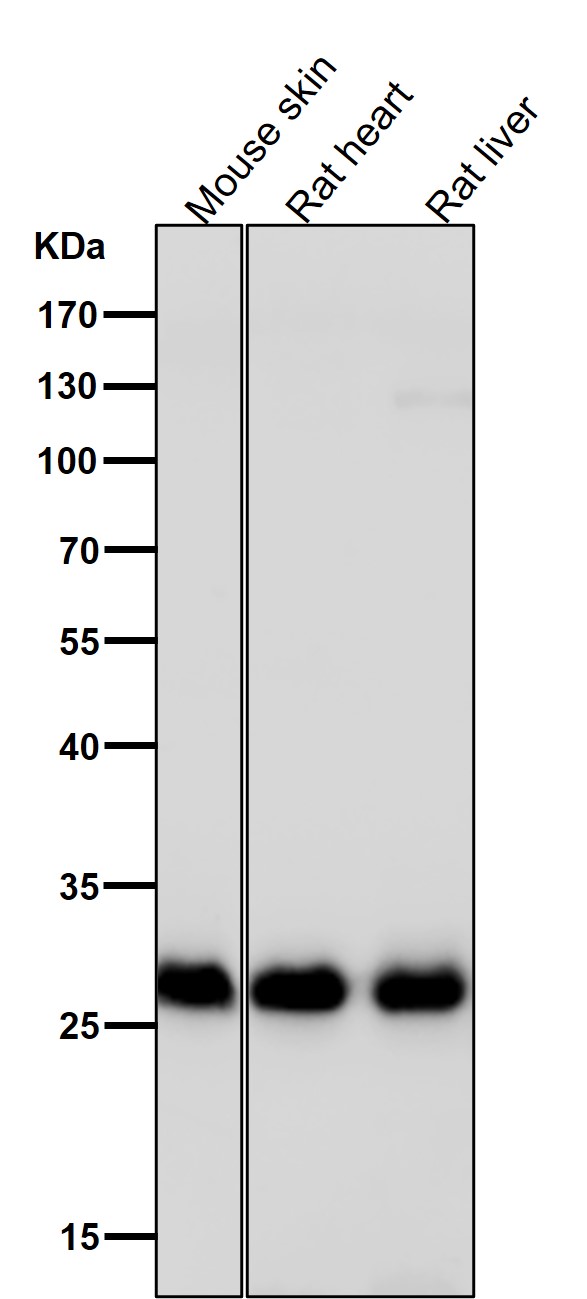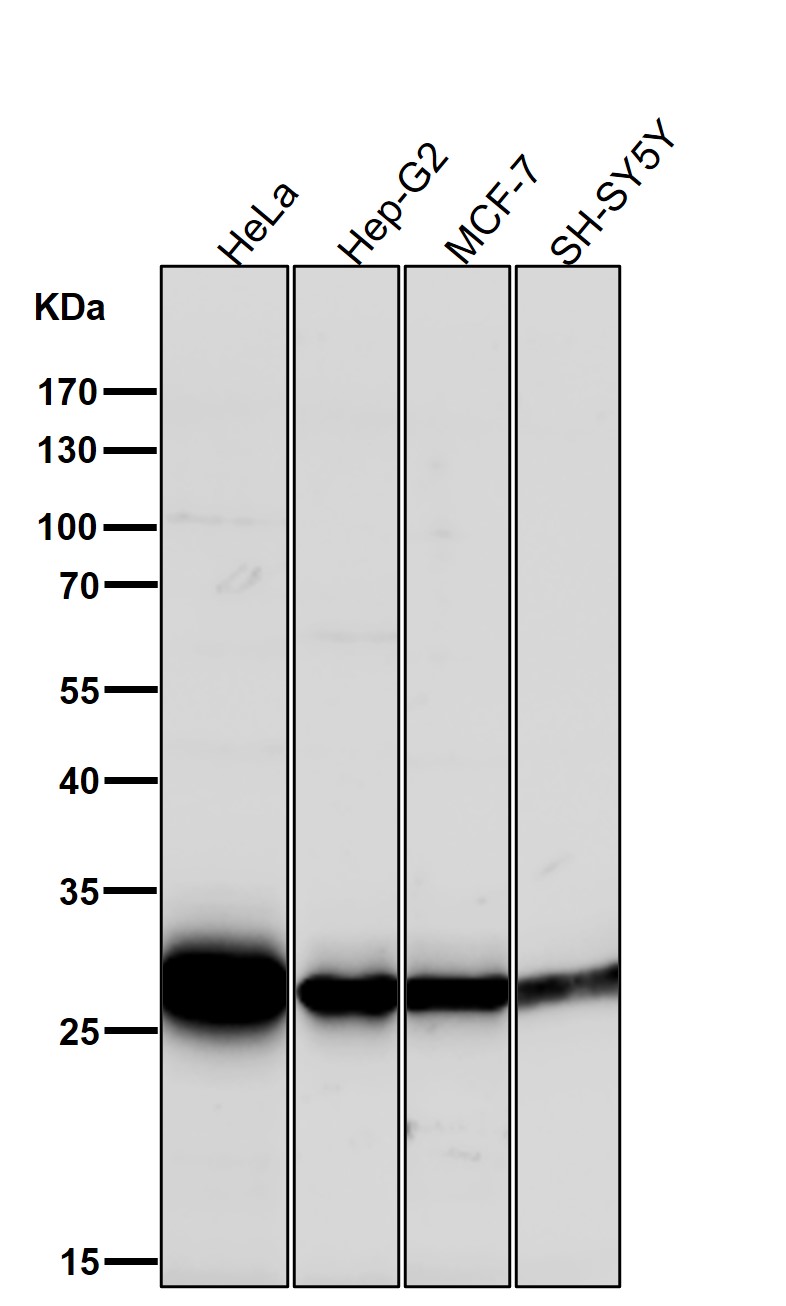


| WB | 咨询技术 | Human,Mouse,Rat |
| IF | 咨询技术 | Human,Mouse,Rat |
| IHC | 咨询技术 | Human,Mouse,Rat |
| ICC | 1/50-1/200 | Human,Mouse,Rat |
| FCM | 1/20-1/100 | Human,Mouse,Rat |
| Elisa | 咨询技术 | Human,Mouse,Rat |
| Aliases | CBP35; Gal-3; 35 kDa lectin; GALBP; IgE-binding protein; Laminin-binding protein; Lectin L-29; Mac-2 antigen; LGALS3; MAC2; Galectin 3; Galectin3;;Galectin 3 |
| WB Predicted band size | Calculated MW: 26 kDa ; Observed MW: 30 kDa |
| Host/Isotype | Rabbit IgG |
| Antibody Type | Primary antibody |
| Storage | Store at 4°C short term. Aliquot and store at -20°C long term. Avoid freeze/thaw cycles. |
| Species Reactivity | Human,Rat |
| Immunogen | A synthesized peptide derived from human Galectin 3 |
| Formulation | Purified antibody in PBS with 0.05% sodium azide,0.05% BSA and 50% glycerol. |
+ +
以下是关于Galectin3抗体的3篇参考文献及其摘要概括:
1. **"Galectin-3: A novel antiapoptotic molecule with a functional BH1 (NWGR) domain of Bcl-2 family"**
- **作者**: Yang RY, Hsu DK, Liu FT
- **摘要**: 该文献揭示了Galectin-3通过其BH1结构域抑制细胞凋亡的机制,并探讨了特异性抗体在阻断Galectin-3抗凋亡功能中的应用潜力,为癌症治疗提供新靶点。
2. **"Targeting galectin-3 in inflammatory and fibrotic diseases"**
- **作者**: Henderson NC, Mackinnon AC, Farnworth SL
- **摘要**: 研究验证了Galectin-3抗体在肝纤维化模型中的治疗作用,证明其通过抑制炎症和胶原沉积减缓纤维化进程,支持Galectin-3作为抗纤维化药物的靶点。
3. **"Galectin-3 as a biomarker for cardiac remodeling after myocardial infarction"**
- **作者**: de Boer RA, Voors AA, Muntendam P
- **摘要**: 该研究利用Galectin-3抗体检测心肌梗死后患者血液中的Galectin-3水平,证实其可作为预测心脏重塑和心力衰竭的生物标志物,具有临床诊断价值。
4. **"Galectin-3 inhibition by a small molecule inhibitor reduces tumor growth in murine models"**
- **作者**: Glinsky VV, Raz A
- **摘要**: 文献报道了一种通过Galectin-3抗体和小分子抑制剂联合抑制肿瘤转移的策略,实验显示其显著降低小鼠模型中肿瘤血管生成和转移率。
以上研究涵盖Galectin3抗体在癌症、纤维化、心血管疾病中的机制探索及治疗应用,反映了其在基础研究与临床转化中的重要性。
Galectin-3. a β-galactoside-binding lectin, plays multifunctional roles in cell adhesion, proliferation, apoptosis, and immune regulation. Overexpressed in cancers, fibrotic diseases, and chronic inflammation, it promotes tumor progression, metastasis, and extracellular matrix remodeling. Its unique structure—a carbohydrate-recognition domain linked to a proline-rich N-terminal region—enables interactions with glycoproteins, influencing signaling pathways like Wnt/β-catenin and RAS. These properties make Galectin-3 a compelling therapeutic and diagnostic target.
Antibodies against Galectin-3. primarily monoclonal (e.g., M3/38. B2C10), are designed to block its pathological functions. They bind to specific epitopes, inhibiting ligand interactions or disrupting oligomerization critical for its activity. In research, these antibodies are tools for detecting Galectin-3 in tissues (e.g., cancer biopsies) or serum via immunoassays (ELISA, immunohistochemistry). Clinically, they hold potential for therapeutic intervention. Preclinical studies show that Galectin-3 blockade reduces tumor growth, fibrosis, and inflammation in models of pancreatic cancer, liver fibrosis, and heart failure. Several antibody-based therapies, including F(ab')₂ fragments and humanized versions, are in development to improve pharmacokinetics and reduce immunogenicity.
Challenges remain in optimizing specificity, delivery efficiency, and minimizing off-target effects. Nonetheless, Galectin-3 antibodies represent a promising avenue for precision medicine, particularly in oncology and fibrotic disorders, with ongoing clinical trials exploring their synergy with existing therapies.
×